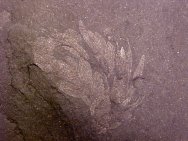Wiwaxia
(Walcott, 1911)
Superphylum Lophotrochozoa, Phylum incertae sedis, Family Wiwaxiidae
Soft-bodied animal, first decribed from the Burgess Shale biota
Geological Time: Middle Cambrian
Size: 21 mmm
Fossil Site: Marjum Formation, House Range, Millard County, Utah
|
Since there are none on the bottom (ventral) surface, the animal partly resembles the slug, a member of the mollusk family. However, mollusks do not have any sclerite armor so the animal's affinity to present day species is unsettled. It did have an anterior jaw with two rows of teeth on the ventral surface, suggesting it was a bottom feeder. Fossil sizes range from 6 to 50 mm. The animal is rare with but 140 specimens known from the Burgess Shale. It is likely that trilobite collectors in Utah have discarded many Wiwaxia and other soft-bodied animals over the years. The material is harder to see than trilobites and many local collectors were simply unfamiliar with soft-bodied animals and didn't recognize what they were. Nonetheless, these animals are as rare as they are hard to see in the Marjum Formation. Also See: Utah Cambrian Explosion Fossils Cambrian Explosion |

 plates.
Because of the sclerites, some researchers have attempted to place
Wiwaxia with the
plates.
Because of the sclerites, some researchers have attempted to place
Wiwaxia with the 
